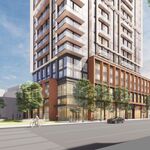Transportation Infrastructure
Federal stimulus funds allow Edmonton to expand LRT service
May 29, 2009
STEPHEN DAFOE
correspondent
Edmonton
With work on the city’s South light rail transit (LRT) expansion nearing completion, an injection of $200 million in stimulus dollars is allowing Edmonton to proceed with six priority transit projects sooner than originally planned.
The federal investment of $100 million, part of $12 billion in new infrastructure stimulus funding through Canada’s Economic Action Plan, will be matched in equal measure by the province and city to complete the estimated $300 million worth of capital infrastructure projects.
The ca sh injection will allow Edmonton to move forward with an expansion of the North-east LRT from Clareview to Gorman Town Centre, as well as an upgrade to the signal system along a portion of the north-east line.
The South LRT will also benefit from the stimulus funding with an extension of LRT platforms.
Additionally, two new park and ride areas will be developed at the proposed Eaux Claires Transit Centre and Heritage Valley Neighbourhood, as well as an expansion to the existing Lewis Estates Park and Ride.
Mike Koziol, general manager of capital construction for the City of Edmonton explained that the opportunity for federal stimulus funding called for shovel-ready projects, infrastructure priorities that were on the planning books and could be substantially completed by Mar. 31, 2011.
“We put together a list of projects we felt we could get designed, tendered and constructed by that time and the federal and provincial governments agreed to six of them,” he said.
“They’re in various stages of design or construction. Some will be completed in 2010 and some will be substantially complete, but not 100 per cent by 2011.”
Among the earliest of the projects to be completed may be the extension of platforms along the South LRT extension from the present four-car length to five.
Koziol explained that $3 million has been allocated for each of the five stations along the line, but he anticipates that the two stations currently under construction along 111 Avenue may come under budget.
“It makes it very easy for us to add the extensions now rather than afterwards,” he said, adding that even at the three stations already opened – Health Sciences, and the recently opened McKernan/Belgravia and South Campus Stations – the work will not be extensive.
“It’s a matter of extending the base, so the foundation has to be added and then the platform on top.”
In addition to providing commuters with more room to stand while they wait for trains, the stimulus infusion will also provide additional places for rail travellers to park with the development of two new park and ride areas.
The $20 million Eaux Claires facility will include about 350 parking spaces and a transit centre, while the $25 million Heritage Valley development will see the creation of a 1,200 to 1,400-space parking lot.
Additionally, $3 million is targeted for the 250-parking spot expansion of the Lewis Estates Park & Ride facility in the city’s north-west end, which is currently under construction.
The lion’s share of the $300 million infrastructure will be consumed by the $210 million expansion of the North-East LRT line from Clareview to Gorman Town Centre, the first northern expansion since the Clareview Station was built in 1981.
The expansion concept plan, approved by Edmonton City Council in July of 2008, calls for expanding the line from Clareview Station at 48 Street and 139 Ave. north-east along an existing right-of-way, ending east of 153 Ave in the centre of the East Gorman development, where a new LRT station will be built.
“We are doing land acquisition and design in 2009 and construction in 2010 and 11,” Koziol said.
“If we get design completed on our crash schedule, we would have it tendered by the end of the year.”
Although Koziol is confident that the stimulus projects will substantially help the construction industry, he could not say how many jobs the six projects might create.
“When we tender it, it is never a requirement to say how many jobs it will create,” he said.
“I just know that that’s a substantial number of projects that we wouldn’t have been able to get under way without the help from the provincial and federal government.”
Koziol explained that the $200 million dollar injection over two years increases the annual LRT construction budget by 50 per cent each year and will allow work originally scheduled for 2011-2014 to be substantially completed before it was supposed to start.




